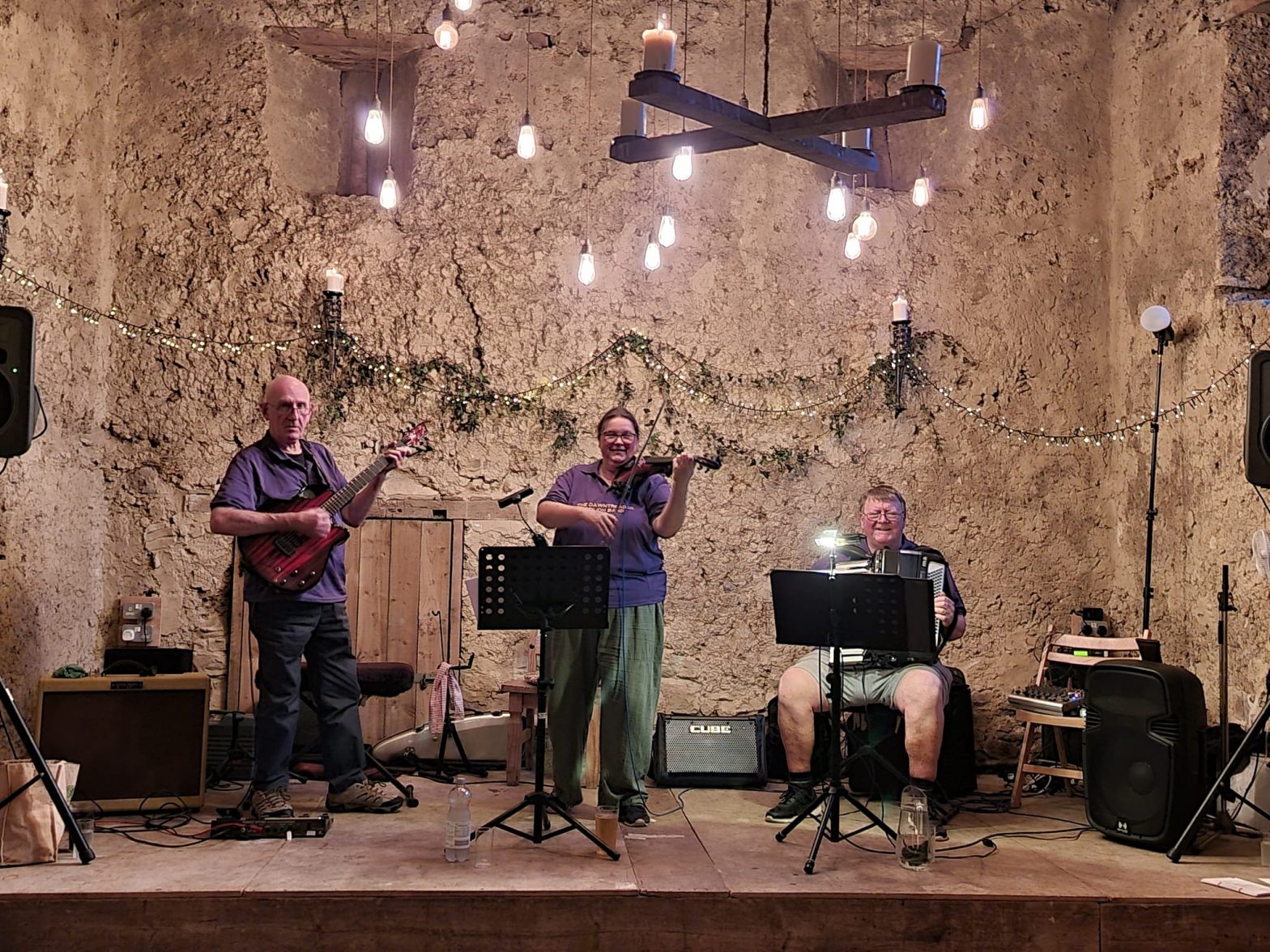The Dawntreaders Are :-
What is a Ceilidh?
Debs
- DEBS, our Caller has been a dancer all her life, and has accumulated a vast amount of knowledge over the years. She takes the time to teach novice and experienced dancers alike, giving the guidance that is needed, whatever your experience. She has called for Wedding Ceilidhs at some of the South West’s most prestigious Country Houses. She has even called for a Ceilidh at a converted Napoleonic Fort!
- At the other end of the scale, she is equally at home calling for Birthday Ceilidhs or Barn Dances at local village halls.She has a comprehensive knowledge of Folk music and Dancing which is put to good use in her duties as a Committee Member for the Annual Teignmouth Folk Festival. Should you have any queries about Ceilidhs, English, Scottish, or other wise, she is the Caller to speak to.
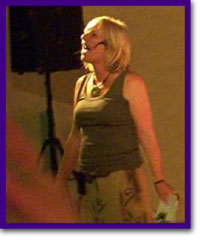
Lynnette
- LYNNETTE has a classical background with Violin and Viola. She has performed with Orchestras all over Europe, and is no stranger to London’s Festival Hall and The Royal Albert Hall. About 20 years ago she decided to swap her Viola for a Fiddle because Ceilidh and Folk Music was more fun!
- Lynnette is probably one of the most dynamic and powerful Fiddle players available in the West Country at the moment. Her playing has to be seen and heard to be believed, dancing all over the stage – she generates so much energy, just what a good Dance Band needs!
- Along with John, Lynn is jointly responsible for our arrangements.
- Lynnette now has a much coveted ‘Bridge’ 5 string Electric Fiddle which she has lovingly named ‘Calvin’. This effectively combines a Viola and a violin into one electric instrument. She makes full use of the capabilities of this versatile instrument.
- Lynn is also available for solo spots, eg playing Classical Music during the signing of the register at weddings.
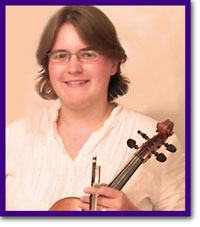
John
- John moved into the area about 15 years go from Kent. Having trained at the Royal College of Music, he has played Keyboards, Accordion and Bass Guitar in a variety of Bands for most of his life. He has also played in many Venues across Europe, including a 5 year stretch as second keys on the musical Starlight Express in Germany. He can play almost every instrument there is, the exceptions being 1) The Scottish Pipes – he can’t stand the ‘noise’ they make, and 2) The Violin – his Father was a classical musician playing….yes the Violin! One of John’s more ‘famous’ Venues has been playing for the Queen at a number of Her Garden Parties at Buckingham Palace.
- His current instrument is the Roland Accordion this is effectively a synthesiser in Accordion shape. It can reproduce a multitude of different instruments, eg Clarinet, Cello, as well as all the classic Accordion voices. It is set up so that the left hand actually reproduces the ‘notes’ of a plucked double bass. So when the Band plays, it sounds like there are four separate instruments.
- He has a vast repertoire of tunes to entertain and get you dancing. As above, John keeps us supplied with sheet music and tune set arrangements. Both John and Lynn have an extensive knowledge of musical theory.
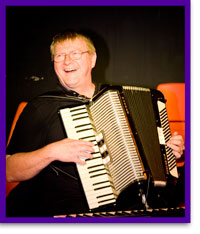
Mel
- MEL, well he just plays Guitar. But it’s his driving rhythm that you find your feet moving to. Mel doesn’t really read music and plays mainly ‘by ear’, but he doesn’t let that get in the way of a good tune. His motto seems to be “You lead, and I will follow”. He likes to think he is in charge, but Lynn, Debs and John know better.
Dance Music, be it Folk, Ceilidh, Ballroom, whatever, needs a Basic Rhythm or Pulse to guide the Dancers. This is Mel’s job, along with the Bass provided by John’s left hand on the Accordion. So many Bands these days are too intricate in their arrangements. I hear time and time again ‘they are brilliant musicians, but you can’t dance to them’. You will never hear that said about The Dawntreaders. Well, you may hear the ‘Brilliant Musicians’ bit!
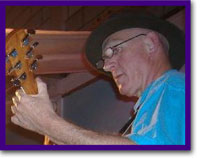
What is a Ceilidh?
Originally, a ceilidh was a social gathering of any sort, and did not necessarily involve dancing. Céilidh music may be provided by an assortment of fiddle, flute, tin whistle, accordion, bodhrán, and in more recent times also drums and electric bass guitar. The music is cheerful and lively, and the basic steps can be learned easily; a short instructional session is often provided for new dancers before the start of the dance itself. In Ireland the first céilidh band was put together in 1926 by Séamus Clandillon, Radio Éireann’s director of Music, in order to have dance music for his studio-based programmes
Dancing at céilidhe is usually in the form of céilidh dances, set dances or couple dances. A “Set” consists of four couples, with each pair of couples facing another in a square or rectangular formation. Each couple exchanges position with the facing couple, and also facing couples exchange partners, while all the time keeping in step with the beat of the music. However, about half of the dances in the modern Scots céilidh are couple dances performed in a ring. These can be performed by fixed couples or in the more sociable “progressive” manner, with the lady moving to the next gentleman in the ring at or near the end of each repetition of the steps. In Ireland, the similar style of dance is called céili dance or fíor (true) céili dance. Some of the dances are named after famous historical battles and events, others after items of daily rural life. The “Siege of Ennis”, “The Walls of Limerick” and “The Stack of Barley” are popular dances in this genre.
These days, a ceilidh or barn dance is simply a dance party with traditional folk music. It is suitable for all ages and, although the dances are generally quite lively, there will be some suited to the very old or young. The movements may often be made by walking, but it’s more fun to dance/step to the tunes. The dancing does not require any experience because a ‘caller’ explains or demonstrates each dance first — it’s easy !
That’s why a ceilidh is so good for weddings or gatherings where people are brought together and wish to share a “fun” experience.






